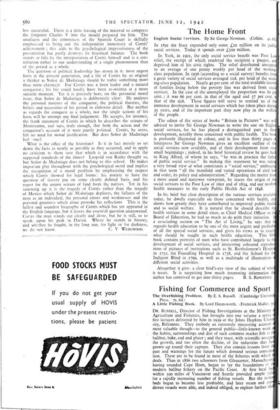The Home Front
English Social !Services. By Sir George Newman. (Collins. 4s. 6a,
IN 1891 the State expended only some £20 million on its publi social services. Today it spends over £500 million.
In York, in 19or, the only social service benefit was Poor La relief, the receipt of which rendered the recipient a pauper, an deprived him of his civic rights. The relief distributed amounte to an average of one penny weekly per head of the working class population. In 1936 (according to a social survey) benefits fro a great variety of social services averaged 'id. per head of the work ing-class population. Nearly 4o per cent. of the total available incom of families living below the poverty line was derived from soci services. In the case of the unemployed the proportion was 80 pe cent. ; it was 66 per cent. in that of the aged and 57 per cent. that of the sick. These figures will serve to remind us of th immense development in social services which has taken place durin 35 years, and of the important part they now play in the welfar of the people.
The editor of the series of books " Britain in Pictures " was we advised to invite Sir George Newman to write the one on Englis social services, for he has played a distinguished part in the development, notably those concerned with public health. The b is profusely illustrated in colour, and in less than thirty pages letterpress Sir George Newman gives an excellent outline of th social services now available, and of their development from ye small beginnings ; indeed, in his brief historical review he goes bac to King Alfred, of whom he says, " he was in practice the fath of public social service." In making this statement he was takin a very broad view of what constitutes a " social service," embracin in that term " all the manifold and varied operations of civil la and order, its policy and administration." Regarding the matter fro a more usual and narrower viewpoint, he traces the origin of th social services to the Poor Law of 16ot and of 1834, and our mode health measures to the early Public Health Act of 1848.
In his brief but clear description of the various services availabl today, he dwells especially on those concerned with health, an shows how greatly they have contributed to improved public heal and to social welfare. It is natural that he should describe th health services in some detail since, as Chief Medical Officer to Board of Education, he had so much to do with their initiation. a concluding section on " The Art of Living," he says that regards health education to be one of the most urgent and profitab of all the special social services, and gives his views as to exact' what should be taught in such health education. This lift book contains portraits of men who have contributed largely to t development of social services, and interesting coloured reprodu tions of pictures of institutions such as St. Bartholomew's Hospit in 1752, the Foundling Hospital in 1738, and the School for t Indigent Blind in 1799, as well as a multitude of illustrations different social activities.
Altogether it give, a clear bird's-eye view of the subject of whi it treats. It is surprising how much interesting information t
author has contrived to get into thirty pages. B. S. ROWNTREE.


























 Previous page
Previous page